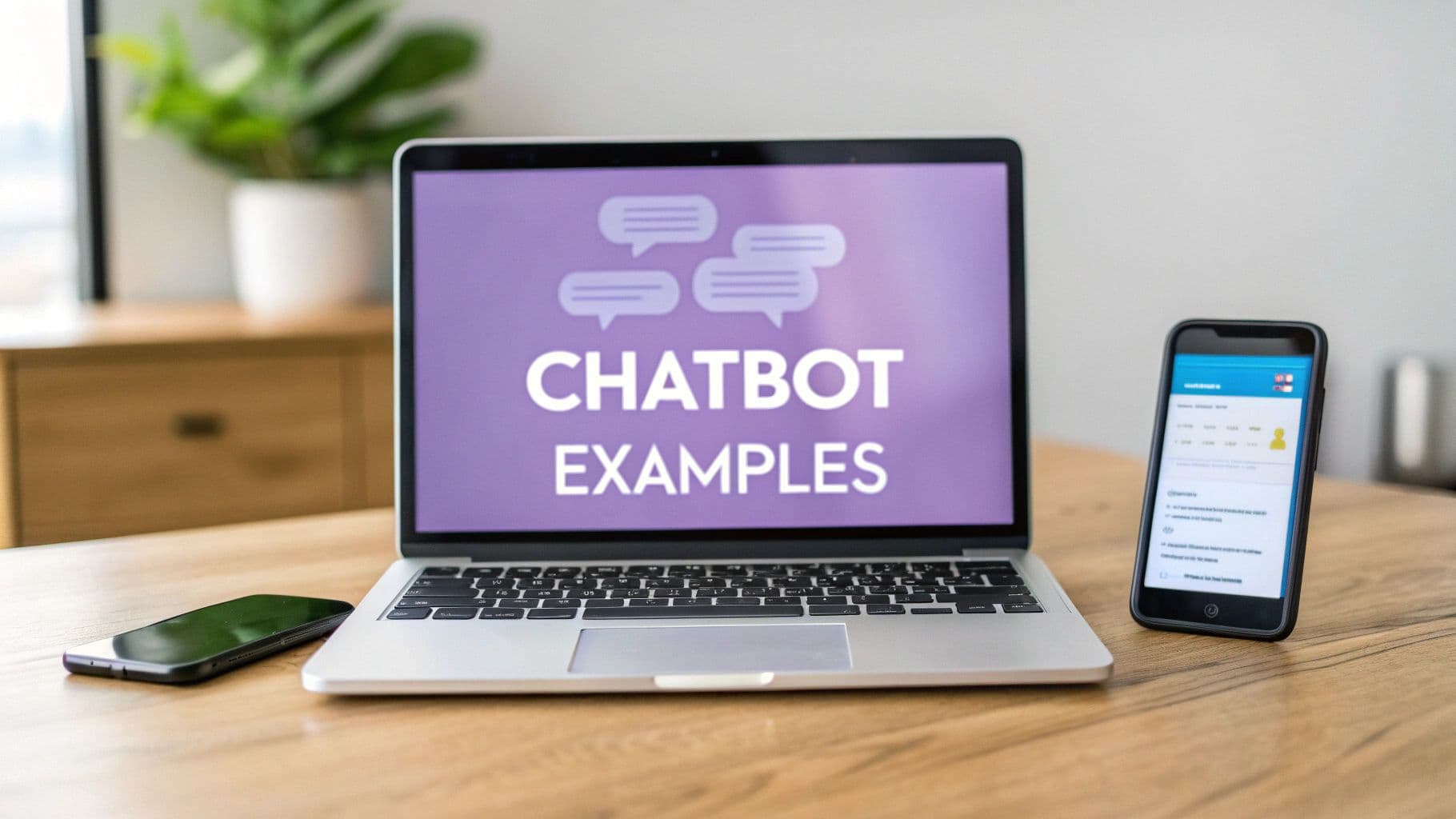Unlocking the Power of Chatbots: Real-World Applications
This listicle provides seven chatbot conversation examples to demonstrate how this technology helps businesses achieve practical goals. Explore real-world applications of different types of chatbots, from customer service to HR and even healthcare, and discover the benefits of using AI chatbots for business growth. We'll cover key features, pros and cons, implementation tips, and leading platforms for each example. See how these chatbot conversation examples can improve customer service, streamline operations, or boost sales for your business. Whether you're an e-commerce retailer or a global enterprise, you'll find inspiration to improve your operations with AI. ManyChat alternative
1. Customer Service Chatbot Conversation
Customer service chatbot conversations are revolutionizing how businesses interact with their customers. These automated dialogues handle a wide range of inquiries, from simple FAQs to complex troubleshooting, and even process requests like order tracking and returns. The core aim is to resolve customer issues efficiently and effectively, all while maintaining a friendly, helpful tone and providing a seamless transition to human agents when necessary. This makes them an invaluable tool for businesses of all sizes, especially those looking for scalable and cost-effective customer support solutions.

These chatbots leverage key features such as Natural Language Processing (NLP) and intent recognition to understand customer needs, even when expressed in different ways. Quick response templates address frequently asked questions instantly, while pre-defined escalation pathways ensure complex or sensitive issues are seamlessly handed off to human agents. Personalization based on customer history adds a tailored touch, and multi-channel support ensures consistent experiences across websites, apps, and various messaging platforms. For advanced conversation flows, explore WhatsApp Business AI. This approach benefits businesses by providing 24/7 availability, consistent responses, reduced wait times, and significant cost savings, particularly during high-volume periods.
Examples of successful implementations abound. Zendesk's Answer Bot resolves support tickets without human intervention, freeing up agents for more complex issues. Bank of America's Erica handles banking inquiries, providing instant support to millions of customers. Sephora's beauty assistant bot on Facebook Messenger offers personalized product recommendations and beauty tips, enhancing the customer experience. Even Domino's Pizza uses a chatbot for streamlined ordering, demonstrating the versatility of this technology.
However, customer service chatbots aren't without their limitations. They may struggle with complex or nuanced requests that deviate from pre-programmed scenarios. Poorly implemented chatbots can frustrate customers, leading to negative experiences. Limited emotional intelligence can also hinder their ability to handle sensitive or emotionally charged situations. Regular updating and maintenance are essential to ensure accuracy and effectiveness, and regional dialects or slang can sometimes pose a challenge.
Tips for Effective Implementation:
- Design clear conversation flows: Map out potential conversation paths with natural exit points to avoid confusing or trapping users.
- Use friendly, conversational language: Match your brand voice and maintain a helpful tone throughout the interaction.
- Include clear options for reaching a human agent: Make it easy for customers to escalate to a human representative when needed.
- Regularly review conversation logs: Analyze transcripts to identify areas for improvement and optimize bot performance.
- Test extensively with real users: Gather feedback and refine the chatbot's responses before full deployment.
Customer service chatbots are particularly beneficial for small and medium-sized businesses seeking scalable, 24/7 customer support. E-commerce retailers can leverage them to improve order management and response times. Customer service teams benefit from the automation of repetitive inquiries, freeing up agents to focus on more complex issues. Digital agencies can offer AI-driven support solutions to their clients, and global enterprises can utilize multilingual chatbots for round-the-clock customer engagement worldwide. Learn more about Customer Service Chatbot Conversation
This approach deserves its place on this list because it represents a fundamental shift in how businesses provide customer support. By leveraging AI and automation, customer service chatbots offer a powerful way to improve efficiency, reduce costs, and enhance the overall customer experience. Companies like Intercom, Zendesk, Drift, LivePerson, and IBM Watson Assistant have popularized this technology, making it accessible to businesses of all sizes. By understanding the features, benefits, and potential pitfalls, businesses can effectively implement chatbot solutions that drive positive results and elevate their customer service capabilities.
2. E-commerce Shopping Assistant Chatbot
E-commerce shopping assistant chatbots are revolutionizing the online shopping experience. These AI-powered tools act as virtual shopping assistants, guiding customers through every step of their journey, from product discovery to post-purchase support. They seamlessly blend product expertise with subtle sales techniques, creating a personalized and efficient shopping experience that benefits both the customer and the business. These chatbots can handle a wide range of tasks, including answering product questions, providing personalized recommendations, managing shopping carts, processing returns, and even tracking orders. This automation allows human agents to focus on more complex issues, leading to increased efficiency and improved customer satisfaction.

Successful implementations of e-commerce chatbots showcase their potential. H&M's shopping assistant on Kik, Sephora's Virtual Artist on Facebook Messenger, and eBay's ShopBot are prime examples. These chatbots demonstrate how businesses can leverage conversational AI to provide personalized product recommendations, facilitate purchases, and offer instant customer support. For instance, Sephora's Virtual Artist allows customers to virtually try on makeup products, while eBay's ShopBot helps customers find specific items amidst a vast inventory. Learn more about E-commerce Shopping Assistant Chatbot For businesses looking to enhance their online stores, an AI chatbot for e-commerce can provide personalized shopping experiences and improve customer service. This type of chatbot conversation example truly demonstrates the power of AI in enhancing customer engagement.
This approach is ideal for e-commerce businesses of all sizes looking to scale their customer service operations, reduce cart abandonment, and boost conversion rates. By offering 24/7 availability and personalized support, these chatbots address the growing demand for instant gratification and tailored experiences in online shopping. This is just one example of how chatbot conversation examples can transform a business.
Features and Benefits:
- Product search and recommendations: Helps customers quickly find what they're looking for and discover related products.
- Cart management: Allows customers to easily add, remove, and modify items in their cart.
- Personalized product suggestions: Tailors recommendations based on customer browsing history and preferences.
- Order tracking integration: Keeps customers informed about the status of their orders.
- Return and exchange processing: Simplifies the returns process, enhancing customer satisfaction.
Pros:
- Increases conversion rates: Guides customers through the purchase funnel, reducing friction and encouraging completion.
- Reduces cart abandonment: Sends reminders and offers assistance to customers who have left items in their cart.
- Provides personalized shopping experience: Creates a tailored experience for each customer, fostering loyalty and repeat purchases.
- Handles multiple customers simultaneously: Scales customer service operations efficiently, reducing wait times.
- Collects valuable customer preference data: Provides insights into customer behavior and preferences, enabling targeted marketing efforts.
Cons:
- Limited ability to understand subjective preferences: May struggle to interpret nuanced language and complex requests.
- May not fully replace the in-store shopping experience: Lacks the tactile and sensory elements of physical shopping.
- Can appear pushy if overly sales-focused: Requires careful balancing of sales techniques with customer service.
- Requires integration with inventory and CRM systems: Implementation requires technical expertise and integration with existing systems.
- Can struggle with complex product configurations: May not be suitable for products with highly customizable options.
Tips for Implementation:
- Focus on understanding customer intent: Prioritize accurate interpretation of customer needs before offering recommendations.
- Implement visual search capabilities: Allow customers to search using images of products.
- Include quick-reply buttons: Streamline common shopping actions with pre-defined responses.
- Design smooth transitions between browsing and checkout: Create a seamless and intuitive checkout process.
- Incorporate cart reminder functionality: Remind customers about items left in their cart.
- Train the bot with product-specific knowledge: Equip the chatbot with comprehensive information about your products and services.
E-commerce shopping assistant chatbots deserve a prominent place in any list of chatbot conversation examples due to their transformative impact on online retail. By providing personalized, efficient, and scalable customer service, these chatbots are enhancing the shopping experience and driving business growth.
3. Healthcare Symptom Checker Chatbot
Healthcare symptom checker chatbots are transforming how people access basic medical information and guidance. These AI-powered tools engage users in conversations, asking questions about their symptoms to provide preliminary assessments, offer basic health information, schedule appointments, and even send medication reminders. This type of chatbot conversation example is becoming increasingly popular due to its potential to improve healthcare accessibility and efficiency. These interactions require careful design, however, balancing helpful guidance with clear medical disclaimers to manage expectations and ensure user safety.

These chatbots work by leveraging a sophisticated combination of technologies. Natural language processing (NLP) allows them to understand and interpret user input, while a comprehensive medical knowledge base provides the information necessary to analyze symptoms. Through a series of targeted questions, the chatbot gathers information about the user's condition and provides relevant feedback. This could include potential causes, self-care advice, or recommendations to seek professional medical attention. Some advanced symptom checkers even integrate with appointment scheduling systems, allowing users to book appointments directly through the chatbot interface.
Examples of successful implementations of healthcare symptom checker chatbots include:
- Ada Health: A popular symptom assessment chatbot known for its detailed questionnaires and personalized health information.
- Babylon Health: Offers AI-powered consultations and connects users with doctors for virtual appointments.
- Woebot: Focuses on mental health support, providing cognitive behavioral therapy (CBT) based guidance.
- Youper: An emotional health assistant that helps users track their mood and provides personalized coping strategies.
- Providence Health's coronavirus assessment bot: Developed specifically to address concerns about COVID-19, guiding users through symptom checks and providing relevant information.
Tips for developing effective healthcare symptom checker chatbots:
- Always include clear medical disclaimers: Emphasize that the chatbot is not a substitute for professional medical advice.
- Design urgent case escalation protocols: Provide clear pathways for users to contact emergency services or speak with a human medical professional when necessary.
- Implement strict data security measures: HIPAA compliance is crucial for protecting sensitive patient health information.
- Use plain language instead of medical jargon: Ensure the chatbot communicates clearly and accessibly to a broad audience.
- Validate content with healthcare professionals: Maintain accuracy and reliability of the medical information provided.
- Provide clear paths to human medical professionals: Offer seamless transitions for users who require further medical evaluation.
Pros of using healthcare symptom checker chatbots:
- Provides 24/7 access to basic health guidance.
- Reduces unnecessary doctor visits for minor ailments.
- Helps prioritize urgent cases by identifying potentially serious symptoms.
- Improves medication adherence through reminders and support.
- Collects health data systematically, which can be valuable for research and personalized care.
Cons of using healthcare symptom checker chatbots:
- Cannot replace professional medical diagnosis.
- Risk of missing serious conditions due to limitations in AI algorithms.
- Legal and regulatory compliance challenges related to data privacy and medical advice.
- Privacy and security concerns regarding sensitive health data.
- May increase anxiety in hypochondriac patients.
Healthcare symptom checker chatbots deserve a prominent place on this list of chatbot conversation examples because they represent a significant advancement in healthcare accessibility. They offer a valuable tool for providing preliminary health guidance, triaging patients, and supporting ongoing care. While these chatbots can't replace doctors, they offer an efficient and convenient way to address basic health concerns, freeing up valuable resources for more complex cases. For businesses in the healthcare space, or those looking to offer employee wellness resources, exploring this type of chatbot can be extremely beneficial.
4. Financial Advisory Chatbot
Financial advisory chatbots are transforming how people interact with their finances. These AI-powered tools provide a convenient and accessible way to manage accounts, track spending, and even receive personalized financial guidance. They work by integrating with existing banking systems and financial data aggregators, allowing users to access information and perform transactions through a conversational interface. This makes it easier than ever to stay on top of financial health, from checking account balances to receiving budgeting tips. Financial advisory chatbots are a prime example of effective chatbot conversation examples, demonstrating how AI can personalize and streamline complex processes.

Examples of successful implementation include Bank of America's Erica, Capital One's Eno, and Wealthfront's automated financial planning bot. These chatbots offer a range of services, from basic account inquiries to sophisticated investment advice (within regulatory limitations). For example, Erica allows Bank of America customers to check balances, transfer money, and even schedule appointments, all through a conversational interface. Similarly, Eno provides Capital One customers with text-based alerts about potential fraud and assists with simple transactions. Wealthfront goes further, offering personalized investment portfolio management through its automated bot.
This approach is particularly valuable for businesses looking to provide 24/7 customer support for financial services. By automating routine tasks and providing readily available information, financial advisory chatbots can free up human agents to focus on more complex inquiries. They also offer a cost-effective alternative to human advisors for basic financial needs, making financial planning more accessible to a wider audience. This convenience makes them ideal for small and medium-sized businesses, e-commerce retailers, and global enterprises alike.
Features and Benefits:
- Account balance and transaction history access: Users can quickly check their financial status.
- Money transfer capabilities: Simplifies moving funds between accounts.
- Spending analysis and categorization: Provides insights into spending habits.
- Budgeting assistance: Helps users create and maintain budgets.
- Investment advice (with regulatory limitations): Offers personalized investment strategies.
- Personalized financial guidance: Tailored advice based on individual circumstances.
- Reduced barriers to financial planning: Makes financial management more approachable.
Pros:
- Convenient 24/7 access to financial services
- Personalized financial guidance
- Reduced barriers to financial planning
- Cost-effective alternative to human advisors for basic needs
- Can encourage better financial habits
Cons:
- Limited complex financial planning capabilities
- Security and privacy concerns
- Regulatory constraints on financial advice
- May struggle with nuanced financial situations
- Trust barriers for handling sensitive financial matters
Actionable Tips for Implementation:
- Implement rigorous security protocols and verification: Multi-factor authentication and fraud detection are crucial.
- Clearly explain financial terms and concepts: Avoid jargon and use plain language.
- Include visual aids for financial data presentation: Charts and graphs can enhance understanding.
- Design clear user consent flows for financial actions: Ensure transparency and user control.
- Develop comprehensive FAQ responses for common financial questions: Address common user queries proactively.
- Ensure compliance with financial regulations: Adhere to all applicable laws and guidelines.
This type of chatbot deserves its place in this list due to its increasing prevalence and the significant impact it has on customer experience within the financial services sector. By providing convenient, personalized, and accessible financial guidance, these chatbots are changing how people interact with their money and empowering them to take control of their financial well-being. They represent a significant step forward in the application of AI to solve real-world problems and improve customer service.
5. Educational Tutoring Chatbot
Educational tutoring chatbots represent a significant advancement in how we approach learning and development. These conversational AI tools act as virtual tutors, providing personalized learning assistance, answering subject-specific questions, administering quizzes, and guiding students through educational content. This approach blends established pedagogical techniques with adaptive learning algorithms, creating a dynamic and supportive learning environment. This makes them a powerful example of chatbot conversation examples, showcasing how AI can transform education.
These chatbots function by leveraging a robust, subject-specific knowledge base. When a student poses a question or requests assistance, the chatbot uses natural language processing (NLP) to understand the query and retrieve relevant information. Interactive quizzes and assessments are integrated to gauge understanding, and step-by-step problem-solving guidance helps students navigate complex concepts. Crucially, educational tutoring chatbots often employ adaptive learning paths. By analyzing student performance, the chatbot adjusts the difficulty and content of subsequent lessons, ensuring an optimal learning experience tailored to individual needs. This personalized approach makes them particularly valuable in diverse learning environments.
Successful implementations of this technology are becoming increasingly common. Duolingo's language learning bot provides an engaging way to acquire new vocabulary and grammar. Carnegie Learning's MATHiaU offers personalized math tutoring, adapting to each student's pace and learning style. QuizBot facilitates vocabulary learning through interactive quizzes, while Replika's AI companion helps develop social skills. For homework help, Socratic by Google leverages AI to provide explanations and resources across a wide range of subjects.
Actionable Tips for Implementing Educational Tutoring Chatbots:
- Design incremental learning paths: Structure the learning journey with gradually increasing difficulty to avoid overwhelming students.
- Encourage and reinforce: Provide positive feedback and encouragement to motivate learners.
- Spaced repetition: Implement spaced repetition algorithms to reinforce knowledge retention over time.
- Multiple explanations: Offer different explanation approaches to cater to diverse learning styles and address challenging concepts.
- Active learning: Design interactions that encourage active participation and critical thinking, moving beyond rote memorization.
- Real-world applications: Connect concepts to real-world scenarios to enhance understanding and relevance.
When and Why to Use Educational Tutoring Chatbots:
Educational tutoring chatbots are ideal for supplementing traditional teaching methods and providing personalized learning support. They are particularly effective for:
- 24/7 Learning Support: Students can access assistance anytime, anywhere, promoting self-directed learning.
- Personalized Pace: Learners can progress at their own speed, fostering a more comfortable and effective learning environment.
- Reduced Anxiety: The judgment-free nature of interacting with a chatbot encourages students to ask questions freely.
- Scalability: These solutions can be deployed to support large numbers of students simultaneously, making them a cost-effective option for educational institutions.
Pros:
- Provides 24/7 learning support
- Offers personalized pace of learning
- Removes fear of judgment when asking questions
- Can adapt to different learning styles
- Scalable for large numbers of students
Cons:
- Limited ability to detect deeper understanding issues
- May not recognize creative but unconventional approaches
- Cannot fully replace human teacher-student relationships
- Knowledge limitations within specialized subjects
- May reinforce rote learning over critical thinking
Learn more about Educational Tutoring Chatbot
Companies like Khan Academy, Duolingo, Carnegie Learning, Google (with Socratic), and Coursera have popularized the use of educational chatbots, demonstrating their potential to revolutionize learning. Whether you're a small business training employees, an e-commerce retailer educating customers, or a global enterprise seeking scalable learning solutions, educational tutoring chatbots provide an innovative and effective way to enhance learning experiences. This technology is particularly beneficial for our target audience, who can leverage these chatbots for efficient and cost-effective training and development programs, personalized customer education, and streamlined internal communications.
6. HR and Employee Onboarding Chatbot
HR and employee onboarding chatbots are transforming the way businesses manage their human resources. These AI-powered tools automate and streamline various HR processes, from answering employee questions to managing leave requests and facilitating onboarding. This type of chatbot conversation example excels at providing instant support and information, creating a more efficient and engaging experience for both HR teams and employees. This deserves a place on this list due to its ability to significantly impact both employee satisfaction and HR productivity, making it a valuable tool for businesses of all sizes.
How it Works:
HR chatbots leverage natural language processing (NLP) and machine learning to understand employee inquiries and provide relevant responses. They are typically integrated with internal HR systems, allowing them to access employee data, company policies, and other relevant information. This integration enables them to handle a wide range of tasks, including:
- Answering policy and procedure questions: Employees can quickly get answers to common questions regarding vacation time, benefits, dress code, and other company policies.
- Facilitating leave requests: The chatbot can guide employees through the leave request process, automatically submitting the request to the appropriate channels for approval.
- Providing company information: New hires and existing employees can access important company information, such as organizational charts, office locations, and contact details, through the chatbot.
- Onboarding assistance: Chatbots can guide new hires through the onboarding process, providing checklists, required documents, and access to training materials.
Examples of Successful Implementation:
Several companies have successfully implemented HR chatbots, demonstrating the effectiveness of this technology:
- IBM's Watson-powered HR assistant: IBM uses Watson's AI capabilities to provide employees with personalized HR support.
- ServiceNow's HR Service Delivery chatbot: This chatbot automates HR case management and provides employees with self-service options for common HR tasks.
- Workday's HR virtual assistant: Workday's chatbot helps employees access information, complete tasks, and receive personalized recommendations.
- Leena AI for employee engagement: This platform focuses on employee engagement, providing support, and answering queries.
- PeopleDoc's HR chatbot solution: This solution streamlines HR document management and provides employees with easy access to their HR records.
Actionable Tips for Implementation:
- Design with employee privacy in mind: Ensure that the chatbot complies with data privacy regulations and protects sensitive employee information.
- Create clear escalation paths to human HR specialists: For complex or sensitive issues, provide a seamless transition to a human HR representative.
- Include personalization based on employee role and tenure: Tailor the chatbot's responses and recommendations based on the individual employee's needs.
- Build in cultural sensitivity for global companies: Ensure the chatbot is adapted to the cultural nuances of different regions if operating in a global environment.
- Implement regular updates aligned with policy changes: Keep the chatbot's knowledge base up-to-date to ensure accurate and consistent information.
- Include conversational prompts for common next questions: Anticipate employee needs and provide helpful prompts for related queries.
Pros and Cons:
Pros:
- Reduces HR team workload for routine inquiries
- Provides consistent policy information
- Accessible outside business hours
- Streamlines onboarding processes
- Creates documented trail of HR interactions
- Reduces time-to-productivity for new hires
Cons:
- May lack nuance for sensitive HR matters
- Cannot fully replace human judgment in complex situations
- Limited emotional intelligence for difficult conversations
- Requires regular updates as policies change
- May be perceived as impersonal by employees
When and Why to Use This Approach:
HR chatbots are ideal for businesses looking to:
- Improve HR efficiency: Automate repetitive tasks and free up HR staff for more strategic initiatives.
- Enhance employee experience: Provide 24/7 access to HR support and information.
- Streamline onboarding: Make the onboarding process smoother and faster for new hires.
- Ensure consistent policy communication: Deliver accurate and consistent policy information to all employees.
By automating routine tasks and providing instant access to information, HR chatbots improve efficiency, enhance the employee experience, and streamline HR processes, making them a valuable asset for any organization looking to modernize their HR operations. This chatbot conversation example is particularly beneficial for the target audience of small to medium-sized businesses, e-commerce retailers, customer service teams, digital agencies, and global enterprises seeking efficient and scalable HR solutions.
7. Travel Planning and Booking Chatbot
Travel planning can be a complex and time-consuming process. Researching destinations, comparing flights and hotels, and managing bookings can quickly become overwhelming. This is where travel planning and booking chatbots step in, offering a streamlined and personalized approach to organizing trips. These chatbots serve as virtual travel agents, guiding users through each stage of the process and providing valuable assistance 24/7. This makes them a powerful example of effective chatbot conversation in action, and a valuable tool for businesses in the travel industry or those seeking to enhance customer service related to travel.
These chatbots work by leveraging natural language understanding (NLU) to interpret user queries and provide relevant information. They connect to various travel databases and APIs to access real-time data on flights, accommodations, attractions, and more. Through interactive conversations, users can define their travel preferences, search for options, compare prices, and even complete bookings directly within the chatbot interface.
Features and Benefits:
Travel planning and booking chatbots boast a range of features designed to simplify travel:
- Destination Recommendation Engine: Based on user preferences, the chatbot can suggest suitable destinations.
- Flight and Hotel Search and Comparison: Quickly search and compare options from multiple providers.
- Booking Management Capabilities: Manage bookings, modifications, and cancellations within the chatbot.
- Itinerary Planning Assistance: Create and manage personalized itineraries.
- Travel Requirement Information: Access information on visas, vaccinations, and other travel requirements.
- Real-time Travel Updates: Receive notifications on flight changes, delays, or gate information.
- Local Attraction and Activity Suggestions: Discover and book local activities and attractions.
Pros:
- Simplifies complex travel planning processes.
- Provides personalized travel recommendations.
- Saves time comparing multiple options.
- Accessible while traveling for itinerary changes.
- Can incorporate local knowledge and tips.
Cons:
- May struggle with highly specific travel requirements.
- Limited ability to understand subjective preferences.
- Complex bookings may require human intervention.
- Challenges with handling unexpected travel disruptions.
- Potential integration issues across multiple travel systems.
Examples of Successful Implementation:
- Kayak's travel planning bot on Facebook Messenger: Allows users to search for flights, hotels, and rental cars, and track prices.
- Expedia's virtual travel agent: Helps users plan and book trips, including flights, hotels, and activities.
- Skyscanner's flight search bot: Focuses on finding the cheapest flights and provides price alerts.
- Booking.com's accommodation assistant: Assists users with finding and booking accommodations.
- KLM's BlueBot for flight information and booking: Provides flight information, booking assistance, and customer support.
Tips for Implementation:
- Implement natural language understanding (NLU) for complex travel queries.
- Design conversation flows that narrow options progressively.
- Include visual elements like maps and photos.
- Incorporate flexible date search options.
- Build in trip modification and cancellation capabilities.
- Design for cross-platform accessibility while traveling.
When and Why to Use This Approach:
This type of chatbot is particularly valuable for:
- Small and medium-sized businesses seeking scalable, 24/7 customer support for travel-related inquiries.
- E-commerce retailers selling travel products or services who aim to improve order management and response times.
- Customer service teams in the travel industry looking to automate repetitive inquiries and reduce costs.
- Digital agencies offering AI-driven support solutions to their clients in the travel sector.
- Global enterprises requiring multilingual, round-the-clock customer engagement for their travel services.
By automating the often tedious aspects of travel planning, these chatbots free up human agents to handle more complex issues and provide higher-value customer service. This streamlined process enhances the customer experience and drives efficiency for businesses operating in the travel industry. This inclusion of chatbot conversation examples demonstrates how automation can transform customer interaction within a specific, and often challenging, vertical.
Chatbot Conversation Examples Comparison
| Chatbot Type | Implementation Complexity 🔄 | Resource Requirements 🔄 | Expected Outcomes ⭐📊 | Ideal Use Cases 💡 | Key Advantages ⭐⚡ |
|---|---|---|---|---|---|
| Customer Service Chatbot | Moderate - requires intent recognition & multi-channel integration | Medium - needs continuous updates & maintenance | Efficient issue resolution, reduced wait times, high scalability | Handling customer inquiries & support 24/7 | 24/7 availability, consistent responses, scalable |
| E-commerce Shopping Assistant | Moderate to High - needs product search, CRM & inventory integration | Medium to High - integration with sales systems and personalization | Increased conversions, reduced cart abandonment, personalized shopping | Guiding customers through online shopping | Boosts sales, personalized experience, handles many users |
| Healthcare Symptom Checker | High - medical knowledge base, compliance & triage required | High - strict security, HIPAA compliance and expert validation | Basic health guidance, reduced unnecessary visits, prioritization | Preliminary health checks and symptom assessment | 24/7 health access, improves medication adherence |
| Financial Advisory Chatbot | High - complex security, regulatory compliance, multi-factor auth | High - stringent security & financial data handling | Convenient financial services, better habits, personalized advice | Account management, budgeting, financial planning | Secure, personalized guidance, accessible anytime |
| Educational Tutoring Chatbot | Moderate to High - adaptive learning paths & knowledge bases | Medium - content updates and adaptive algorithms required | Personalized learning, scalable tutoring, knowledge tracking | Learning assistance, quizzes, homework help | Personalized pace, scalable, supports various learning styles |
| HR and Employee Onboarding Chatbot | Moderate - policy info systems & document processing | Medium - regular policy updates and privacy considerations | Streamlined onboarding, consistent HR info, reduced workload | Employee onboarding, FAQs, leave management | Reduces HR load, accessible anytime, consistent info |
| Travel Planning and Booking Chatbot | High - complex booking, multi-system integrations & real-time updates | Medium to High - requires travel data, booking engine access | Simplified travel planning, personalized recommendations | Flight/hotel booking, itinerary creation | Saves time, adaptive travel assistance, cross-platform accessibility |
Elevating Your Business with Intelligent Chatbots
This exploration of chatbot conversation examples, spanning customer service, e-commerce, healthcare, finance, education, HR, and travel, showcases the transformative power of conversational AI. We've seen how these intelligent virtual assistants can automate repetitive tasks, personalize user experiences, and provide 24/7 support, effectively addressing the diverse needs of today's businesses. From optimizing order management and reducing response times for e-commerce retailers, to streamlining employee onboarding processes for HR teams, and even offering multilingual customer engagement for global enterprises, mastering the nuances of chatbot implementation is crucial for achieving significant growth and enhanced customer satisfaction. The key takeaway is that by understanding these various chatbot conversation examples, businesses can strategically leverage this technology to not only meet customer expectations but exceed them.
These examples are just the beginning. The potential applications of chatbots are vast and continuously evolving. By embracing this technology, businesses can unlock new opportunities for efficiency, scalability, and personalized engagement, ultimately building stronger customer relationships and driving impactful business outcomes.
Ready to transform your business with the power of intelligent chatbots? Explore the possibilities with FlowGent AI and discover how to seamlessly build, deploy, and manage your own custom chatbot solutions. Visit FlowGent AI today to learn more and start creating exceptional conversational experiences.



